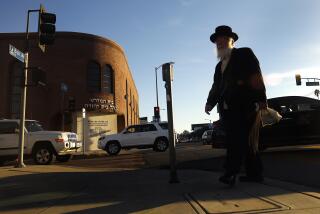3,000-Year-Old Heritage Is Difficult to Maintain
When Suzanne Rosen converted to Judaism 20 years ago, the intricate rituals of the Passover Seder were new and exciting.
She carefully followed her mother-in-law’s directions to prepare her kitchen for the feast commemorating the liberation of Jews from slavery and their exodus from Egypt 3,000 years ago. She emptied her cabinets of all dishes, pots, pans, utensils and food. She scrubbed the refrigerator, cleaned the stove with high heat and relined every shelf. In came a whole new set of cookware and dishes used only for the ritual meal. When the eight-day holiday ended, she reversed the whole process.
“They do this because thousands of years ago, the Jews didn’t even have enough time for their bread to rise,” she said. “That’s why it’s so important. God forbid there’s a little bit of bread somewhere.”
Now a Huntington Beach mother of three, Rosen admits the elaborate rituals are hard to keep up. Today for Passover she cleanses one corner of the kitchen and ensures it remains untouched by food not considered kosher. She cleans out and lines two shelves of the refrigerator for her mother-in-law’s dishes.
“It’s been a slow evolution,” Rosen said. “I thought it was fascinating, and even today I enjoy the rituals. It’s just that the whole turning over of the kitchen seems like too much. I got pragmatic.”
Reenacting the precise experience of ancestors who lived 3,000 years ago can be complicated. Even Orthodox Jews can use some refresher courses for the elaborate ceremony that marks the Passover holiday, which begins this year on March 31.
“There are people who have done this year in and your out, and for them it is always a challenge,” said Rabbi Allan Kalinsky, director of the Los Angeles-based Orthodox Union. “Sometimes they forget things from the past, the traditions.”
So the Union’s Rabbi Zorach Spira will be waiting at a Ralph’s grocery at 5331 University Drive in Irvine at 7:30 p.m. on March 15 to lead the faithful but confused on a Passover tour. It is just one of several workshops held around the county this month to help families figure out the joyous but ritually complicated High Holy Days.
“We go up and down the aisles and point out the ones that are kosher for Passover,” Kalinsky said. “It’s very informative.”
The group likely will have a lot of takers. Passover, which refers to the “passing over” of Jewish homes while the angel of death inflicted the 10th plague on Egypt, is a holiday celebrated at home. Families prepare the symbolic Seder plate, read the Exodus story in the Haggada, and eat matzo ball soup, salted vegetables and other symbolic foods. Jews who don’t go near a synagogue all year will celebrate their heritage, even if they need a little brushing up on the story.
Polls done within the wide variations of Judaism show that the Passover Seder is the most celebrated of the holidays, said Nehemia Ichilov of the Bureau of Jewish Education in Costa Mesa.
“It’s a wonderful excuse to get the whole family together,” Ichilov said. “Most of the story is chronological. It’s understanding that we were slaves and we were in a time of persecution. It brings you to the point where you look to the future. This is where we came from, and this is where we strive to be.”
One of the obligations of the Seder is to tell the story and go through it as if the teller were actually experiencing it.
The term “Seder” means order or organized, Ichilov added; it refers to the ritual aspects of the meal, the songs, the drinking of the wine and the reading of the Haggada.
Rabbi Yossi Mentz of the Hebrew Academy in Huntington Beach agrees that Passover can be difficult to do just right, especially for those who are less religiously observant the rest of the year.
“A lot of people, if they don’t do anything at all, they would celebrate Passover and Yom Kippur,” he said, referring to the Jewish Day of Atonement.
He is offering a workshop from 12:30 to 3:30 p.m. at the academy, 14401 Willow Lane, on March 14. Mentz will go over the story and the symbolic meaning of each dish expected on the table.
“People want to understand why they’re eating matzo,” he said. “You get a lot of people who don’t understand why they’re doing this: ‘Why were we slaves? Why are we celebrating Passover?’ ”
To get everyone in the spirit, Mentz has commissioned an authentic brick oven of the type used by his ancestors millenia ago.
While teaching the story to some 7,000 adults and children over the next few weeks, he’ll explain the importance of the unleavened bread called matzo, a key ingredient of the Seder.
Others sitting down to Seder the first night of Passover won’t be quite so particular.
Alan Jacobs, a leader of the Pacific Community of Secular Humanistic Jews in Newport Beach, said the 100 or so members of his group will celebrate the political meaning of the day.
“We’re considered kind of nutty,” conceded Jacobs, who represents agnostics and atheists in the faith. “The Red Sea dividing and the other miracles are meaningless to us. We celebrate the message of freedom and the message of rejecting tyranny.”
(BEGIN TEXT OF INFOBOX / INFOGRAPHIC)
Passover Traditions
Passover is known by many names--’Festival of Freedom,’ ‘Feast ofUnleavened Bread’--but whichever is preferred, it commemorates theliberation from slavery and the exodus of the Jewish people from ancientEgypt.
“To understand who we are today as a people, we need to go through the story of who we were in the past--that’s the custom and the tradition behind Passover,” said Nehemia Ichilov, director of community education for the Bureau of Jewish Education in Costa Mesa.
Called Pesach in Hebrew, Passover begins on the 15th day of the Jewishmonth of Nisan, and is observed starting Friday evening. Outside Israel,the holiday is commonly celebrated for eight days.
Activities center around the home, family and food, although some synagogues have special morning services during the week. Synagoguessometimes hold a community or congregational Seder on one evening. A highlight of Passover is the Seder, a ritual meal served in the homethe first two nights. The dinners tend to be large, with some familiesinviting their non-Jewish friends to enjoy the unique experience.
The Passover story:
More than 3,000 years ago, a cruel Pharoah came into power in Egyptand forced the Jews into servitude, ordering that every Jewish boy bekilled. One mother saved her baby by floating him down the river in abasket. The Pharaoh’s daughter found the baby, named him Moses and raisedhim as an Egyptian prince.
God later told Moses to ask the Pharaoh to let his people go. Pharaohdidn’t listen and so God punished the Egyptians with 10 plagues,cuminating with death to the firstborn. Moses told the Jews to painttheir doors with the blood of a sacrificed lamb so the angel of deathwould ‘pass over’ the Jewish homes.
When Pharaoh’s own son died, he freed the slaves. The Jews quickly left Egypt, not even waiting for their bread to rise. Egyptian soldiers pursued them to the Sea, which parted for the Jews’ eventual safe passage to Canaan.
The Seder:
This communal dinner includes prayers, songs and stories from aspecial prayer book called a Haggadah. Alongside the Seder plate,containing symbolic foods of Passover, is a bowl of saltwater for dippingvegetables and three pieces of matzo covered with a special cloth.
The meal is supposed to be eaten in a reclining position--as areminder of the comforts of freedom--hence, a cushion is placed oneveryone’s left side.
During the evening, adults drink four glasses of wine symbolizing thepromises God made to Moses: that God would bring the Jews out of Egypt,deliver them from slavery, redeem them with an outstretched arm and makethem a nation.
An extra place setting is reserved for the prophet Elijah, who Jewsbelieve will come to announce peace among all the world’s peoples. His wine cup is filled, but left untouched. The door is opened after the meal so Elijah may enter.
In practice, families may vary in how strictly they follow the ritualor in how they handle each tradition.
Passover foods:
Before Passover, many families rid their homes of forbidden foods:those made with grain, such as wheat, rye, barley, oats. Common examplesinclude bread, cereal, pasta and even some liquor. More traditionalfamilies will transfer these forbidden foods, called hametz, to anon-Jewish family through a formal bill of sale, to be reclaimed afterPassover.
Only flour-like matzo meal and potato starch are used in cooking andthe only processed foods that are allowed are those that been preparedunder special supervision. Special utensils and dishes are used duringPassover.
Favorite dishes:
chicken
brisket
turkey
gefilte fish (mixture of chopped fish)
potatoes
carrot tsimmes (carrot dish)


